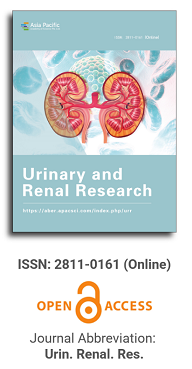
Asia Pacific Academy of Science Pte. Ltd. (APACSCI) specializes in international journal publishing. APACSCI adopts the open access publishing model and provides an important communication bridge for academic groups whose interest fields include engineering, technology, medicine, computer, mathematics, agriculture and forestry, and environment.
Arterial hypertension and the kidney: The fatal duo of chronic noncommunicable diseases
Vol 1, Issue 1, 2020
Download PDF
Abstract
Chronic noncommunicable diseases are the leading cause of death in the world. Among them, cardiovascular diseases occupy first place in mortality and the main risk factor is hypertension, which is usually asymptomatic until the harmful effects manifest themselves. There is a strong relationship between hypertension and the kidney, since on the one hand hypertension is the major risk factor for the initiation and progression of kidney disease and at the same time hypertension is the result of kidney disease itself. In this review, different aspects of arterial hypertension were analyzed in a general way, such as prevalence, classification, etiology, heritability and relationship with chronic noncommunicable diseases and the importance of the kidney in the regulation of blood pressure; as well as renal disease and its relationship with hypertension and the deleterious consequences for health.
Keywords
References
- Ahmeda, A. F., & Alzoghaibi, M. (2016). Factors regulating the renal circulation in spontaneously hypertensive rats. Saudi Journal of Biological Sciences, 23(4), 441-451.
- Anari, R., Amani, R., Latifi, S. M., Veissi, M., & Shahbazian, H. (2017). Association of obesity with hypertension and dyslipidemia ¬in type 2 diabetes mellitus subjects. Diabetes and Metabolic Syndrome, 11(1), 37-41.
- Barba Evia, J. R. (2018). Mexico and the challenge of chronic noncommunicable diseases. The laboratory also plays an important role. Mexican Journal of Clinical Pathology and Laboratory Medicine, 65(1), 4-17.
- Brenner, B. M., Garcia, D. L., & Anderson, S. (1988). Glomeruli and blood pressure. Less of one, more the other? American Journal of Hypertension, 1 (4Pt 1), 335-347.
- Britten, R. J., & Davidson, E. H. (1969). Gene regulation in higher cells. Science, 165(3891), 349-357. doi: 10.1126/scien- ce.165.3891.349.
- Burton, M. A., & Lillycrop, K. A. (2019). Nutritional modulation of the epigenome and its implication for future health. The Proceedings of the Nutrition Society, 78(3), 305-312.
- Campos Nonato, I., Hernández-Barrera, L., Pedroza-Tobías, A., Medina, C., & Barquera, S. (2018). Arterial hypertension in Mexican adults: prevalence, diagnosis, and type of treatment. ENSANUT MC 2016. Public Health of Mexico, 60(3), 233-243.
- Curtis, J. J., Luke, R. G., Dustan, H. P., Kashgarian, M., Whel- chel, J. D., Jones, P., & Diethelm, A. G. (1983). Remission of essential hypertension after renal transplantation. The New England Journal of Medicine, 309(17), 1009-1015.
- De Taeye, B., Smith, L. H., & Vaughan, D. E. (2005). Plasminogen ¬activator inhibitor-1: a common denominator in obesity, diabetes and cardiovascular disease. Current Opinion in Pharmacology, 5(2), 149-154.
- Ettner, R., Ettner, F., & White, T. (2012). Secrecy and the ¬pathogenesis of hypertension. International Journal of Family Medicine, 2012, 492718.
- Feihl, F., Liaudet, L., Waeber, B., & Levy, B. I. (2006). Hypertension¬: A disease of the microcirculation? Hypertension, 48(6), 1012-1017.
- Gargiulo, R., Suhail, F., & Lerma, E. V. (2015). Hypertension and chronic kidney disease. Disease-a-month: DM, 61 (9), 387-395.
- Gekle, M. (2017). Kidney and aging - A narrative review. Experimental Gerontology, 87(Pt B), 153-155.
- Global Burden of Disease Study 2016 Risk Factors Collaborators ¬(2017). Global, regional, and national comparative risk assessment of 84 behavioural, environmental and occupational¬, and metabolic risks or clusters of risks, 1990-2016: A systematic analysis for the Global Burden of Disease Study 2016. The Lancet, 390(10100), 1345-1422. doi: 10.1016/S0140- 6736(17)32366-8.
- Gu, Q., Burt V. L., Paulose-Ram, R., Yoon, S., & Gillum, R. F. (2008). High blood pressure and cardiovascular disease mortality risk among U.S. adults: The third National Health and Nutrition Examination Survey mortality follow-up study. Annals of Epidemiology, 18(4), 302-309. doi: 10.1016/j.an- nepidem.2007.11.013.
- Guyton, A. C., Coleman, T. G., Cowley, A. V., Scheel, K. W., Manning, R. D., & Norman, R. A. (1972). Arterial pressure ¬regulation. Overriding dominance of the kidneys in long-term regulation and in hypertension. The American Journal of Medicine, 52(5), 584-594.
- Guyton, A. C., & Hall, J. 巳(2007). Treatise on medical physiology (7th ed.). Mexico: Elsevier.
- Hsu, C. N., & Tain, Y. L. (2019). Regulation of nitric oxide ¬production in the developmental programming of hypertension ¬and kidney disease. International Journal of Molecular Sciences, 20(3), pii: E681. doi: 10.3390∕ijms20030681.
- Kalaitzidis, R. G., & Bakris, G. L. (2010). Prehypertension: Is it relevant for nephrologists? Kidney International, 77(3), 194200¬. doi: 10.1038/ki.2009.439.
- Kapil, V., & Lobo, M. D. (2014). Hypertension. Medicine, 42(9), 485-490. doi: 10.1016/j.mpmed.2014.06.004.
- Kasko, M., Budaj, M., & Hulin, I. (2012). Harmful or helpful hypertension-pathophysiological basis. In M. Khullar (Ed.), Genetics and pathophysiology of essential hypertension (pp. 5-30). Croatia: InTech.
- Landmesser, U., & Drexler, H. (2007). Endothelial function and hypertension. Current Opinion in Cardiology, 22(4), 316-320.
- Mehta, P. K., & Griendling, K. K. (2007). Angiotensin II cell signaling: Physiological and pathological effects in the cardiovascular system. American Journal of Physiology: Cell Physiology, 292(1), C82-C97.
- Méndez-Durán, A. J., Méndez-Bueno, J. F., Tapia-Yáñez, T, Muñoz-Montes, A., & Aguilar-Sánchez, L. (2010). Epidemiology ¬of chronic renal failure in Mexico. Dialysis and Transplantation, 31(1), 7-11. doi: 10.1016/S1886-2845(10)70004-7.
Supporting Agencies
Copyright (c) 2020 Aguilera-Méndez Asdrúbal, Nieto-Aguilar Renato, Serrato- Ochoa Deyanira, Manuel-Jacobo Gema Cecilia

This work is licensed under a Creative Commons Attribution-NonCommercial 4.0 International License.

This site is licensed under a Creative Commons Attribution 4.0 International License (CC BY 4.0).
.png)
Prof. Wei-Yen Hsu
National Chung Cheng University, Taiwan

